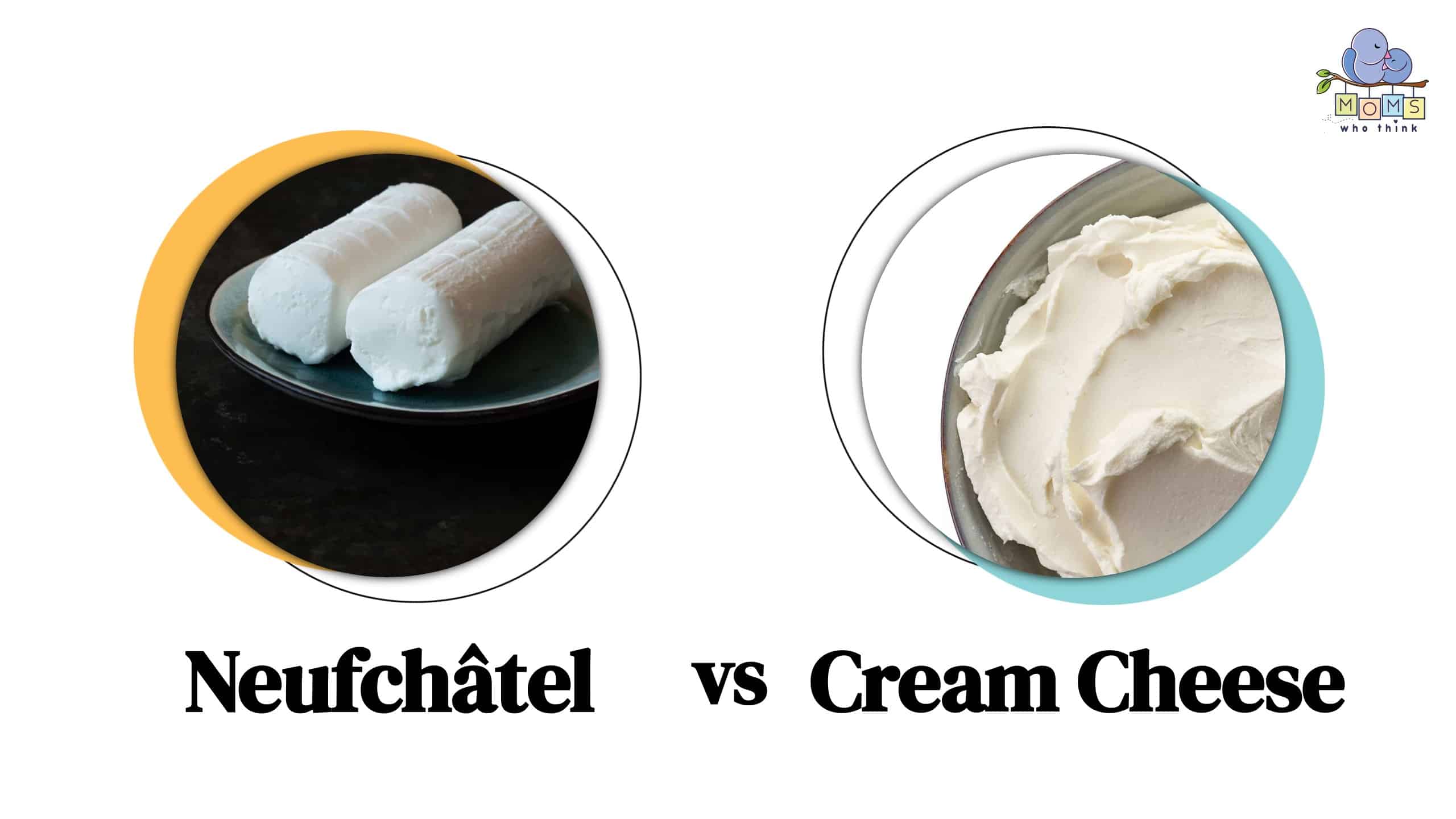If you're a busy parent who loves to cook, you know that cheese can add flavor and creaminess to your dishes. But with so many types of cheese out there, it can be hard to know which one to use. Today, we're going to talk about two popular cheese options: Neufchâtel cheese and cream cheese.
While these two cheeses may look similar, they differ in terms of flavor, texture, and use in the kitchen. In this article, we'll explore the similarities and differences between Neufchâtel cheese and cream cheese.
- The must-have convenient reference guide for every home cook!
- Includes more than 8,000 substitutions for ingredients, cookware, and techniques.
- Save time and money on by avoiding trips to grab that "missing" ingredient you don't really need.
Neufchâtel Cheese vs. Cream Cheese: What Is the Difference?
The primary difference between Neufchâtel and cream cheese is their fat content. Neufchâtel typically contains 23% fat content while cream cheese is around 33%. Neufchâtel originates in France and is made from cow's milk while cream cheese was popularized in the United States. They differ in their flavor and texture as well. Cream cheese is mild, smooth, and creamy while Neufchâtel is delicate, has a grainy texture, and is mushroomy and tangy in flavor.
While both cheeses can be used interchangeably in recipes, it's important to know their differences as their flavor and texture can impact the final product.
Let's take a closer look at each cheese to gain a better understanding of what sets them apart.
Neufchâtel Cheese vs. Cream Cheese Nutrition: Calories, Fat, and Protein for Each
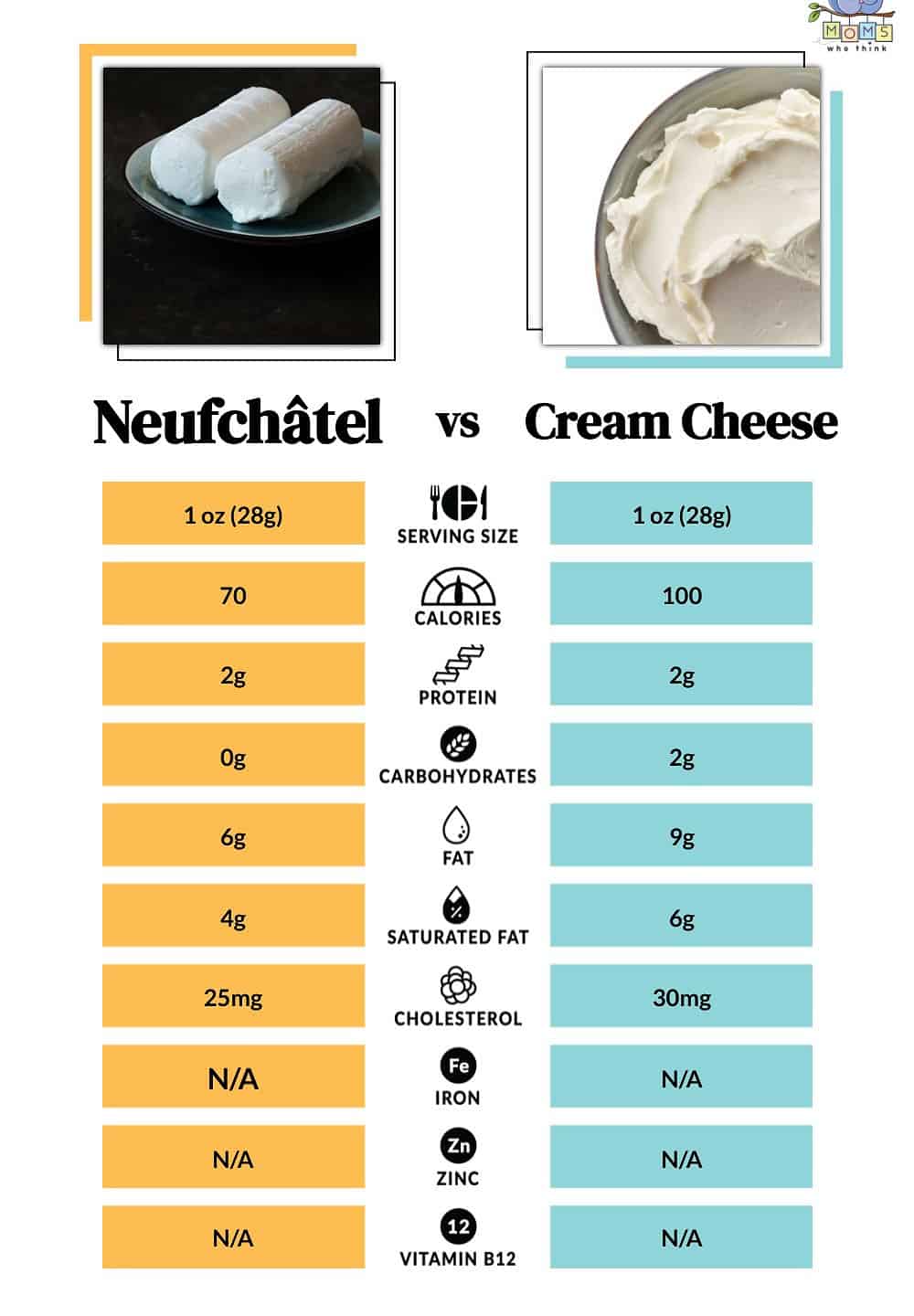
Nutritional comparison of Neufchâtel vs. cream cheese
©
In general, Neufchâtel has fewer calories per ounce than cream cheese. While Neufchâtel has about 70 calories per ounce, cream cheese is closer to 100 calories, with higher fat content. Its worth noting that many of the cream cheeses you see on store shelves can have extremely variable calories per serving. For example, nonfat cream cheese often has just 30 calories per serving. Of course, that reducation in calories come with impacts on creaminess and flavor.
What is Neufchâtel Cheese?
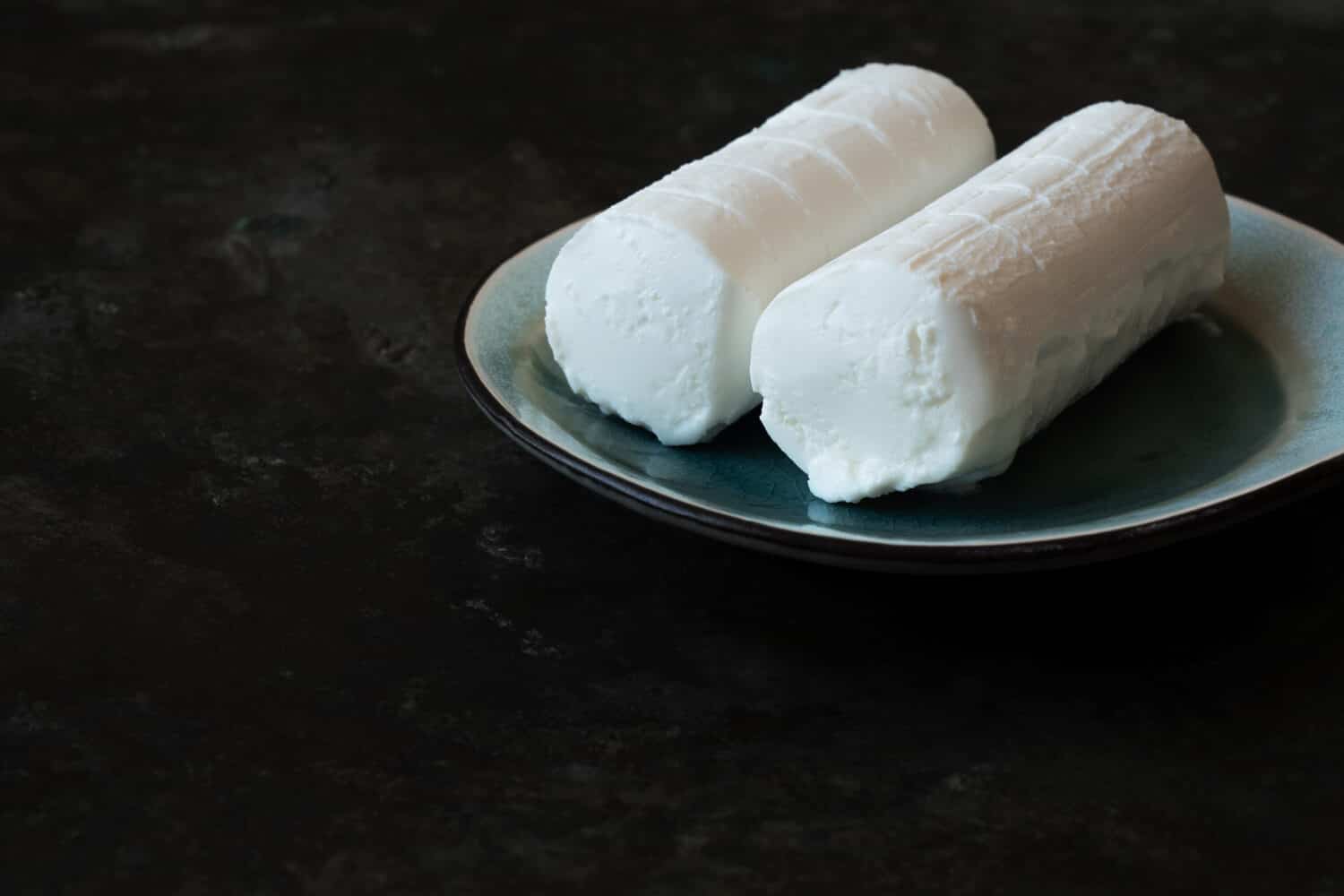
Neufchâtel cheese is a soft, spreadable cheese that's popular in France.
©Pedal to the Stock/Shutterstock.com
Neufchâtel cheese is a soft, slightly crumbly cheese that originated in France. While it seems similar to cream cheese, it has a few differences that set it apart. For instance, Neufchâtel cheese is made strictly from cow's milk instead of cream and has a lower fat content.
Here's an in-depth look at the French cheese and how it differs from cream cheese.
Origin
According to cheese.com, Neufchâtel cheese originated in the Neufchâtel-en-Bray region of Normandy, France, beginning all the way back in 1035. This cheese is also traditionally produced in a heart shape in France, due to the legend of farm girls creating this cheese in a heart shape to give it to the English soldiers during the Hundred Years War.
Flavor
Neufchâtel cheese has a slightly tangy, slightly nutty taste. It's somewhat similar in flavor to cream cheese, but it's not quite as sweet or rich. Additionally, traditional French Neufchâtel cheese can be left to mature, giving it an even tangier flavor.
Texture and Appearance
Neufchâtel's texture is also slightly crumbly, which sets it apart from the smooth, spreadable texture of cream cheese. Despite its slight crumbliness, Neufchâtel's still a spreadable cheese whether at cold or room temperature. As this cheese ages, it also develops a slight rind, similar to brie.
- The must-have convenient reference guide for every home cook!
- Includes more than 8,000 substitutions for ingredients, cookware, and techniques.
- Save time and money on by avoiding trips to grab that "missing" ingredient you don't really need.
How Neufchâtel Cheese Is Made
It's important to note that traditional Neufchâtel cheese is only produced in France where unpasteurized cow's milk is used. In the United States, pasteurized cow's milk is used, deviating from the original French recipe.
Because cow's milk is used to make Neufchâtel, it has a lower fat content than cream cheese, which uses milk and cream in the production process. Cream cheese typically contains around 33% milk fat, and Neufchâtel cheese only contains 23-29% milk fat.
Neufchâtel is created from curdled cow's milk. The curds are then separated from the liquid (whey), salted, and molded to create the cheese. Neufchâtel is also intended to be eaten fresh. However, as mentioned, some Artisan forms of the cheese are allowed to age, giving it a tangier flavor and stronger rind.
Popular Uses
Neufchâtel is extremely versatile. Because of its spreadable texture, it's popularly used as a topping on crackers, bagels, or toast. It can also be used as a filling for sandwiches or in dips, spreads, or baked goods.
What Is Cream Cheese?

Cream cheese is often spread on bagels for a creamy touch of sweetness.
©Toasted Pictures/Shutterstock.com
Similar to Neufchâtel, cream cheese is a soft, white, fresh cheese that also doesn't require any aging. Cream cheese, though, is higher in fat content and has a slightly sweeter flavor.
Origin
Cream cheese originated in the United States in the late 1800s. It's thought that a dairy farmer named William Lawrence first created cream cheese in Chester, New York. In his attempts to add more cream to Neufchâtel, he ended up creating the cream cheese we know today. His creation process eventually turned into the Philadelphia Cream Cheese brand that is now mass-produced.
Flavor
Cream cheese has a mild and slightly tangy flavor that tastes incredibly similar to Neufchâtel. As mentioned, however, due to the addition of cream in cream cheese's recipe, it has a higher fat content which gives it a slightly richer taste.
Texture and Appearance
Cream cheese is an off-white dense cheese that has a thick texture. It also has less moisture than Neufchâtel, adding to its density. Cream cheese is still incredibly spreadable, though, making it an easy choice for spreading on top of bagels, crackers, and other foods.
How Cream Cheese Is Made
As mentioned, cream cheese is made with a combination of milk and cream. Lactic acid is then added to create curdling. The whey is then removed from the curds, and the curds are heated and then formed. This cheese is also fresh, so it's ready to eat immediately and doesn't require aging.
It's also possible to make cream cheese at home. Simply add salt and either vinegar or lemon juice to cream or a mixture of cream and milk. When curds form, strain them and puree them in a blender or food processor.
Popular Uses
Like Neufchâtel, cream cheese is a versatile ingredient that can be used in both sweet and savory recipes. Its uses are quite similar to neufchâtel as well. It's most popularly used as a spread for bagels, toast, and crackers, but it can also be used in dips and frosting. Cream cheese is a key ingredient in classic desserts like cheesecake and carrot cake frosting. It can also be used in pasta sauces, casseroles, and dips.
Can You Substitute Neufchâtel Cheese with Cream Cheese?
In short, yes, cream cheese can substitute Neufchâtel cheese in many recipes. Cream cheese was in fact created to mimic Neufchâtel back in the 1800s.
It's important to note, however, that because Neufchâtel has less fat content than cream cheese, swapping one for the other may alter the taste and texture of your dish. For example, if a recipe calls for cream cheese as a main ingredient (like in cheesecake or frosting), try adding a small amount of milk or cream to Neufchâtel in order to get a similar fat content to cream cheese. The higher fat content will aid in achieving a similarly rich and creamy texture, and sweeter taste.
- The must-have convenient reference guide for every home cook!
- Includes more than 8,000 substitutions for ingredients, cookware, and techniques.
- Save time and money on by avoiding trips to grab that "missing" ingredient you don't really need.
Other Substitutes for Neufchâtel and Cream Cheese
If you're in a pinch, or unable to substitute Neufchâtel for cream cheese and vice versa, here are a few other dairy ingredients you can try:
Greek Yogurt
Greek yogurt can make a great replacement for cream cheese or Neufchâtel in dips and spreads. Its thick and creamy texture and tangy flavor are closely similar.
Ricotta Cheese
In recipes that call for a soft, creamy cheese, ricotta cheese can be used as a substitute. It has a slightly grainy texture and a mild, slightly sweet flavor that is similar to Neufchâtel.
Cottage Cheese
Cottage cheese can be blended until smooth and used as a substitute for Neufchâtel and cream cheese in dips and spreads. Its mild flavor and creamy texture work well in both savory and sweet recipes.
Mascarpone
Mascarpone cheese is similar to cream cheese in texture and flavor, but it's slightly sweeter and richer. It works well as a substitute for cream cheese in desserts like cheesecake and frosting.
Neufchâtel or Cream Cheese Recipes
Use either Neufchâtel or cream cheese in the following recipes for a creamy finish:
Print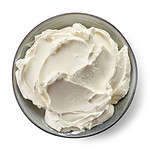
Pumpkin Cream Cheese Dessert
Ingredients
- ½ cup butter
- ⅓ cup white sugar
- 18 whole graham crackers (2 packages), crushed
- 2 eggs
- ¾ cup white sugar
- 1 (8 ounce) package cream cheese, softened
- 1 envelope (1 Tablespoon) unflavored gelatine
- ¼ cup water
- 1 (15 ounce) can pumpkin
- 3 eggs, separated
- ½ cup milk
- ½ cup white sugar
- ½ teaspoon salt
- 2 teaspoons ground cinnamon
- ½ pint whipped cream
Instructions
- Preheat oven to 350°F (175°C). Lightly grease a 9×13 inch baking dish.
- In a medium saucepan over medium heat, melt butter. Stir in the sugar and mix well. Stir in graham cracker crumbs. Pat the mixture into baking dish.
- In a medium mixing bowl, beat together the egg yolks, sugar and cream cheese. Pour the mixture over crust.
- Bake 20 minutes in the preheated oven. Remove from heat and allow the mixture to cool. In a small bowl, dissolve the gelatine in water.
- In a medium saucepan over medium heat, mix the pumpkin, eggs, milk, sugar, salt and cinnamon. Reserve the egg whites.
- Stirring constantly, cook until thick, about 4 minutes. Remove from heat and mix in the gelatine. Allow the mixture to cool for approximately 20 minutes.
- In a small bowl, beat the 3 egg whites until stiff. Gently fold the egg whites into the cooled pumpkin mixture.
- Pour the pumpkin mixture over the cream cheese mixture. Top with whipped cream. Cover and refrigerate approximately 2 hours.
Final Thoughts
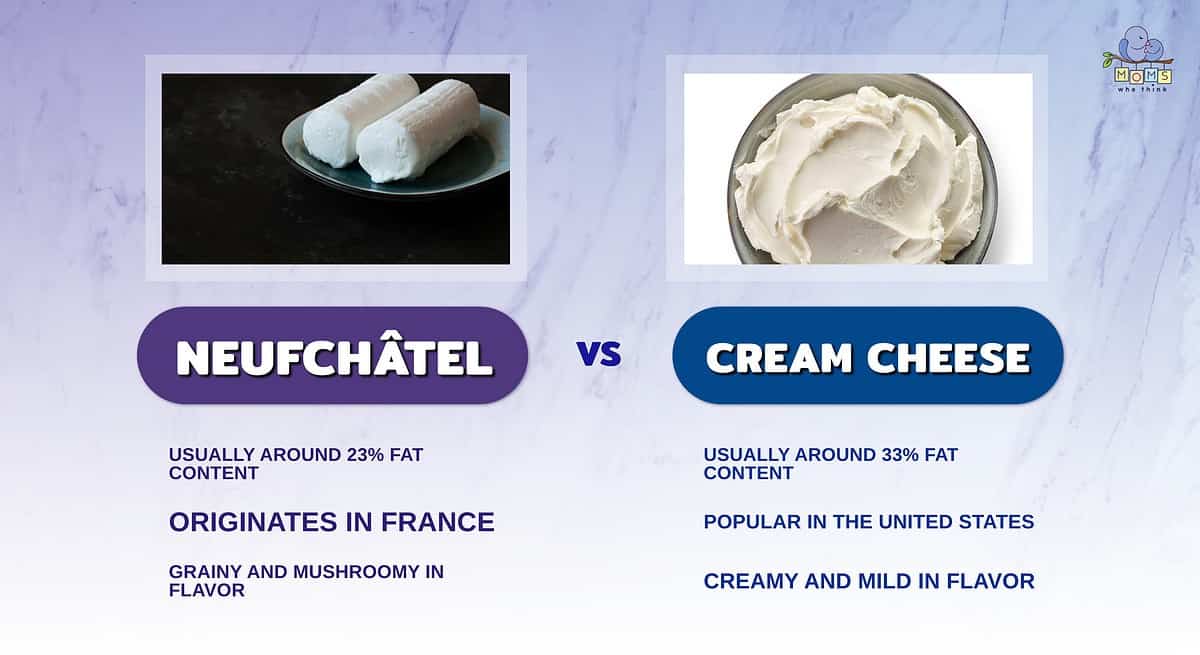
- The fat content in Neufchâtel and cream cheese differs. Neufchâtel has a lower fat content, generally, than cream cheese.
- Cream cheese was popularized in the United States, while Neufchâtel originated in France.
- Neufchâtel is quite unique, with its grainy texture and mushroom-like flavor. Cream cheese has a mild flavor and smooth creaminess.
In conclusion, Neufchâtel and cream cheese are two creamy, decadent cheeses that can add richness and depth to your next recipe. While these cheeses may look similar at first look, they differ in terms of flavor, taste, and production process.
Whether you're making a savory dip or a sweet dessert, Neufchâtel and cream cheese can help you master your next culinary creation.
